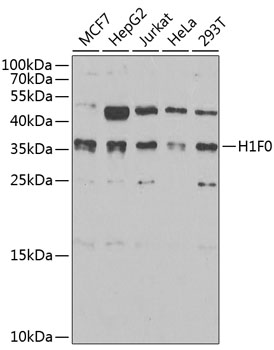![Histone H1(AE-4), CF405S conjugate, 0.1mg/mL [26628-22-8] Histone H1(AE-4), CF405S conjugate, 0.1mg/mL [26628-22-8]](https://biotium.com/wp-content/uploads/2016/12/Histone-AE-4-CF568-PFA-HeLa-3ug-mL-CF488A-Phalloidin.jpg)
Histone H1(AE-4), CF405S conjugate, 0.1mg/mL [26628-22-8]
BNC040096
ApplicationsFlow Cytometry, ImmunoFluorescence, ImmunoPrecipitation, Western Blot, ChIP Chromatin ImmunoPrecipitation, ImmunoHistoChemistry, ImmunoHistoChemistry Paraffin
Product group Antibodies
TargetH1-0
Overview
- SupplierBiotium
- Product NameHistone H1(AE-4), CF405S conjugate, 0.1mg/mL [26628-22-8]
- Delivery Days Customer9
- ApplicationsFlow Cytometry, ImmunoFluorescence, ImmunoPrecipitation, Western Blot, ChIP Chromatin ImmunoPrecipitation, ImmunoHistoChemistry, ImmunoHistoChemistry Paraffin
- CertificationResearch Use Only
- ClonalityMonoclonal
- Clone IDAE-4
- Concentration0.1 mg/ml
- ConjugateOther Conjugate
- Gene ID3005
- Target nameH1-0
- Target descriptionH1.0 linker histone
- Target synonymsH1.0, H10, H1F0, H1FV, histone H1.0, H1 histone family member 0, H1.0, H1(0), H1-0, histone H1', histone H1(0)
- HostMouse
- IsotypeIgG2a
- Scientific DescriptionEukaryotic histones are basic, water-soluble nuclear proteins that form hetero-octameric nucleosome particles. They wrap 146 base pairs of DNA in a left-handed supealpha-helicalturn sequentially to form chromosomal fiber. Two molecules of each of the four core histones (H2A, H2B, H3, and H4) form the octamer; formed of two H2A-H2B dimers and two H3-H4 dimers, forming two nearly symmetrical halves by tertiary structure. Over 80% of nucleosomes contain the linker Histone H1, derived from an intronless gene that interacts with linker DNA between nucleosomes and mediates compaction into higher order chromatin. Histones are subject to posttranslational modification by enzymes primarily on their N-terminal tails, but also in their globular domains. Such modifications include methylation, citrullination, acetylation, phosphorylation, sumoylation, ubiquitination and ADP-ribosylation. Primary antibodies are available purified, or with a selection of fluorescent CF® Dyes and other labels. CF® Dyes offer exceptional brightness and photostability. Note: Conjugates of blue fluorescent dyes like CF®405S and CF®405M are not recommended for detecting low abundance targets, because blue dyes have lower fluorescence and can give higher non-specific background than other dye colors.
- SourceAnimal
- Storage Instruction2°C to 8°C
- UNSPSC12352203

![Histone H1(AE-4), CF405S conjugate, 0.1mg/mL [26628-22-8] Histone H1(AE-4), CF405S conjugate, 0.1mg/mL [26628-22-8]](https://biotium.com/wp-content/uploads/2016/12/Histone-AE-4-CF568-MeOH-HeLa-3ug-mL.jpg)
![Histone H1(AE-4), CF405S conjugate, 0.1mg/mL [26628-22-8] Histone H1(AE-4), CF405S conjugate, 0.1mg/mL [26628-22-8]](https://biotium.com/wp-content/uploads/2016/12/BNUB0096-1-1.jpg)
![Histone H1(AE-4), CF405S conjugate, 0.1mg/mL [26628-22-8] Histone H1(AE-4), CF405S conjugate, 0.1mg/mL [26628-22-8]](https://biotium.com/wp-content/uploads/2016/12/BNUB0096-0-1.jpg)




